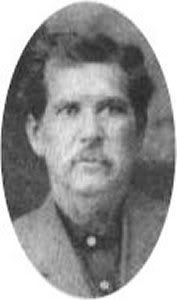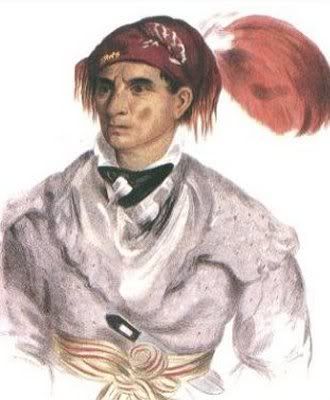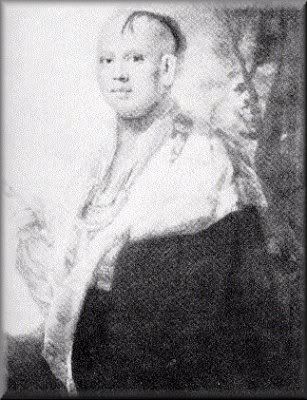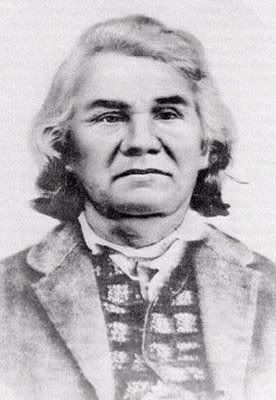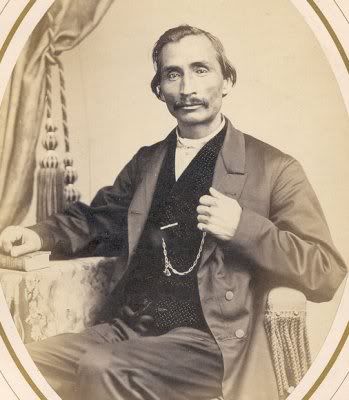Redbird Smith
( Cherokee )
1850-1918.
Born on July 19, 1850, near Fort Smith, Arkansas, Redbird Smith would become a principal chief and a Cherokee tradionalist who resisted allotment and Oklahoma statehood. His Cherokee father was called Pig Redbird Smith (so named because he was a blacksmith); his mother was a Cherokee named Lizzie Hildebrand. Redbird Smith's family felt strongly about their Cherokee traditions and threat to their continuance.
After the Civil War, traditionalist families such as the Smiths rallied around the Keetowah Society (named after the Cherokee word 'kituwah', meaning "key") to protect themselves against capricious land appropiation by Union armies in Indian Territory. Originally organized by Evan Jones and his son John, the Keetowah Society became less active during the 1870s und 1880s when federal threats to Native American power in Indian Terretory ebbed.
In the 1890s, however, a new challenge to the Cherokee land base surfaced. When the Dawes Commission came to Indian Terretory in 1893, it wanted to regain control over lands that were ceded to the Five Civilized Tribes (Cherokee, Creek, Choctaw, Chickesaw, and Seminole) when they were removed from the East. White settlers or "sooners" had been coming into Indian Terretory, and they were pressuring the federal government to legitimize their claims and lands.
The resulting General Allotment Act or Dawes Severalty Act of 1887 called for the abolition of communal landholdings and the allotment of parcels of land in 160-acre tracts to tribal members. It also provided that such allottees become citizens in due course and that a new state, Oklahoma, be created. Many traditionalst Cherokees resisted such land and statehood plans through the Keetawoh Society. They lobbied the U.S. Congress to exempt the Five Civilized Tribes from such allotment policies. In 1893, the federal government voided the exemption of the Five Civilized Tribes from allotment policies and established the Dawes Commission to dispense with tribal lands.
To the further chagrin of the traditonalists, Congress enacted the Curtis Act in 1898, which abolished tribal governments and created civil governments in Indian Territory. Under these circumstances, Redbird Smith and other traditionalists revitalized the Keetawoh Society to stop federal assaults on tribalism. But there soon developed a split in the ranks of the Keetowahs, with one faction resigning itself to losing autonomy while the other group opposed any capitulation to governmental policies. Redbird Smith sought to reconcile the two groups so that united they could become stronger. He also reached out to traditionalists in all of the Five Civilized Tribes through the Four Mothers Society that he founded in 1912. The Keetowahs collected monthly dues to hire lawyers, lobby Congress, and travel to Washington. With powerful economic interests arrayed against them, it appeared that no one could keep the land speculators, oil men, and railroads from gaining what they wanted in Congress. In this heated environment, Redbird Smith's adherents were known as the Nighthawk Keetowahs because they met at night in order to keep their political strategies secret. The Keetowahs encouraged many Cherokees to refuse enrollment during the U.S. census of 1900. Such disruptive activities caused much bureaucratic confusion. In 1902, Redbird Smith was arrested for refusing to enroll. Although he continued to resist enrollment, the government enrolled him by force. Protesting enrollment and allotment in Washington, Redbird Smith stated, "I can't stand and live and breath if I take this allotment." However, his protests in Washington were futile. In despair, he returned to Indian Terretory and told his people that any more resistance was hopeless. In 1905, under federal pressure, the Cherokees became the last tribe to sign the allotment agreement.
In 1907, the former Indian Territory became the state of Oklahoma. Smith became principal chief of the Cherokees in 1908; many of Smith's followers withdrew to the Cookson Hills of northeastern Oklahoma, hoping to preserve their way of life and avoid white interference in their affairs. Late in life he was active in preserving traditional ways among the Five Civilized Tribes through the Four Mothers Society. On November 8, 1918, he died in Oklahoma. He was survived by his wife, Lucy Fields Smith.
Tah-chee
( Cherokee )
Tah-chee or "Dutch" was a Western Cherokee chief who refused to move from Arkansas to the Indian Territory and took his group to settle in east Texas. The Texas Cherokees were forced to move to Indian Territory after a bloody battle with the army of the Republic of Texas in the 1840's.
Ostenaco
( Cherokee )
Ostenaco was a war chief who, in 1756, joined the English in a campaign against the French-allied Shawnee during the Seven Years War ("French and Indian War). His warriors were abandonned by the British troops when their provisions were lost while crossing a swollen river. His band "confiscated" horses from the ungrateful Virginians who retaliated by killing 24 of his party. A period of retaliatory raids begain between the Cherokee and colonists. In 1762, the Cherokee captured Fort Loundon (near present Venore TN). Eventually, devastation of the Cherokee country by large colonial armies forced the Cherokee to sue for peace. Lt. Henry Timberlake volunteered to stay with the Cherokee to improve Cherokee-English relations. Ostenaco, along with Stalking Turkey and Pouting Pigeon, visited London in 1762 to see King George III accompanied by Lt. Henry Timberlake and interpreter, William Shorey, who died in route.
Stand Watie
( Cherokee )
Stand Watie, leader of the Southern Cherokees, was a Treaty Party leader and signer of the Treaty of New Echota. Named Ta-ker-taw-ker, "to stand firm", at birth and formally Degadoga, "he stands on two feet", he was baptized as Isaac. He later combined the English version of his name with his father's name, Oo-wa-tie, resulting in Stand Watie. His brother was Buck Oowatie who took the name Elias Boudinot in honor of a wealthy benefactor. He was the nephew of Major Ridge. Of the four main leaders of the Treaty Party (the others being Major Ridge, John Ridge, and Elias Boudinot), he was the only one to escape assasination in 1839. Siding with the Confederacy in the American Civil War, he rose to the rank of Brigider General -- the only Native American general in the Civil War. His predominately mixed-blood troops participated in the battles of Wilson's Creek MO and Pea Ridge AR and battles in the Cherokee Nation at Cabin Creek and Honey Springs. After Chief John Ross's "capture", he was elected principal chief in August of 1862. He holds the distinction of being the last Confederate general to surrender -- June 23, 1865 -- two months after Lee's surrender in Virginia.
Lewis Downing
( Cherokee )
Lewis Downing (Lewie-za-wau-na-skie) was born in Eastern Tennessee in 1823, being a son of Samuel Downing and Susan Daugherty, his wife. She was a daughter of Cornelius Daugherty, an Irishman, and his full blood Cherokee Indian wife. Samuel Downing was a son of John and Jennie Downing and this John Downing was a son of Major Downing and his Cherokee wife. Major Downing was a British army officer and supervised the manufacture of powder for the troops.
Young Downing came west with the party led by Jesse Bushyhead and Evan Jones in 1839 and settled near the old Baptist Mission near Westville, in Goingsnake District and in what is today, Adair County, Oklahoma. He attended school at the Valley Town Mission and later at the Baptist Mission under the tutelage of Rev Evan Jones. Early in life, he became a convert of the famous missionary and subsequently was ordained to the Baptist ministry. Reports of his spiritual activities reach back to 1842 when he was but nineteen years of age. On August 3, 1844, he was unanimously chosen pastor of the Flint Baptist Church, succeeding the Rev. Jesse Bushyhead who had passed away shortly before. The efforts of Lewis Downing during those early years were devoted to his Baptist ministry in which he was aided by Rev. Evan Jones.
The young minister was a strong adherent of the Ross faction in Cherokee Nation politics and as such was elected senator from Goingsnake District on August 4, 1845. He later removed to a farm on Spring Creek, Saline District and in what is today the southeast corner of Mayes County, Oklahoma, where he was elected to the senate on August 4, 1851, and again on August 1, 1859. He was sent as a delegate from the tribe to Washington in 1851. His political activities ran contemporaneously with his spiritual labors.
Came the Civil War with its potential menace of tribal dissension among the Cherokees and the rather halting assent of Chief John Ross to an alliance with the Confederacy. The smoldering embers of discord lingering from the Ridge-Boudinot assassinations of 1839 seemed ready to burst forth anew but were promptly suppressed by the astute Chief when he formed the First Regiment of Cherokee Mounted Rifles for the Confederate service at Park Hill on October 4, 1861. Lewis Downing was named chaplain of companies F and S of this regiment of which Col. John Drew was the commanding officer. The members of this regiment were mostly full bloods, were not slave owners and, at heart, were abolitionists. They were probably mostly members of the Keetoowah Society. This regiment fought in the Confederate service at Pea Ridge, Arkansas, on March 7-8, 1862, but with the advance of the Union forces into the Territory in July, 1862, and the departure of Chief John Ross for Philadelphia, its members began to waver in their allegiance to the South. With few exceptions, among them being Col. John Drew, the members of this regiment began to abandon the Confederate service and, on July 11, 1862, at Flat Rock Creek, joined in forming the Third Indian Home Guards for service in the Union army. This contingent was composed of three regiments consisting of 1480 men, of which Lewis Downing was named Lieut. Colonel and the Rev. John B. Jones was designated its chaplain, in the brigade of Col. Wm. A. Phillips. Rev. John B. Jones and his father, who were agabolitionists, had been influential in provoking this change. The cleavage so created resulted in the formation of dual governments in the Cherokee Nation, each striving to control its political affairs. The Union Cherokee government, which recognized John Ross as chief, held its meetings at Cowskin Prairie where, in July, 1862, allegiance to the Confederacy was renounced and on February 21, 1863, laws of emancipation were enacted and future slavery abolished. Chief John Ross being absent in the East, the political affairs of the Union Cherokees were managed by a coterie of leaders, of whom Lewis Downing was the presiding spirit. This duplication in Cherokee tribal governments obtained from July, 1862, until the conclusion of the war.
Lewis Downing, who was president of the Union tribal council, went to Washington, in 1863 to enlist the attention of the government in the Cherokee situation. After the conclusion of the war, a preliminary intertribal peace conference with the United States commissioners, was held at Ft. Smith. This meeting was opened on September 8, 1865, by prayer offered by Rev. Lewis Downing. It was at this meeting that Lewis Downing protested against the refusal of the commissioners to accord recognition to John Ross as the chief of the Cherokees. Ross returned to Tahlequah for a brief period in the fall of 1865 but returned to Washington the next year to urge his protest against the approval of section nine of the treaty of June 19, 1866, wherein the Cherokees were required to adopt their former negro slaves into tribal membership. The provisions of this disputed section were approved by the Rev. John B. Jones who accompanied the old chief as a delegate and who signed the treaty as such.
Chief John Ross passed away at Washington on August 1, 1866, and Lewis Downing automatically became chief of the Cherokee Nation serving as such until October 19, 1866, when William Potter Ross was chosen by the council to fill the vacancy.
Much bitterness lingered between the contending elements among the Cherokees, following the cessation of hostilities. These sentiments were not entirely indigenous to the Cherokee Indians, but extended throughout the country. The problem of "binding up the Nation's wounds" became one which lay in the years ahead. Among the Ross faction of the Union Cherokees were many who insisted upon the exclusion of the Confederate Cherokees from all participation in tribal affairs. There were sentiments that the penalties for their Southern activities had not been entirely exhausted. Already, many drastic, illogical things had been done. Lewis Downing was opposed to any discriminating policies and at this initial point, his sentiments of tribal unity were crystalized by the formation of what was to become known as the Downing Party, in the political life of the Cherokee Nation. Rev. John B. Jones threw his power and influence among the full bloods, behind the Downing movement which was to rehabilitate the Southern Cherokees and align them with the erstwhile Union Cherokees, without favor or discrimination. The success of the movement was reflected in the tribal election held on August 5, 1867, when Lewis Downing was elected chief of the Cherokees, having behind him the support of both factions. Faithful John Buttrick Jones rendered no greater service to the Cherokees than he did in the summer and fall of 1867. The Downing party thereafter controlled the political affairs of the Cherokee Nation until Statehood save for the regime of Chief Dennis W. Bushyhead of from 1879 to 1887.
The tenure of Chief Lewis Downing were the years of reconstruction among the Cherokees. In his efforts, he enjoyed the full confidence of all factions as he strove to harmonize the discordant elements. Indicative of his attitude toward the Southern Cherokees are the words from his first message to the Council in the fall of 1867, wherein he says, "By the treaty of 1866, Canadian District was set apart as a sort of land of refuge for that portion of our people who sided with the Confederate States in the late war. In making this arrangement, some important distinctions were made between the rights and remedies of the people of this district and those of the rest of the Nation. These distinctions were made at the earnest and persistent solicitation of certain gentlemen sent to Washington as the representatives of the Southern Cherokees. The reason assigned for these distinctions was, that the Southern Cherokees could not with safety reside among the rest of the people, or get justice in their Courts, on account of the part they had taken in the late war. But all the Southern Cherokees know now that all such fears are groundless, for notwithstanding the setting apart of Canadian District as above named, a large majority of the Southern Cherokees have returned to their Old Homes in the other districts and live there among the rest of the people in peace and security. The very great importance of the entire unity of our Nation cannot have escaped your attention. Our laws should be uniform, the jurisdiction of our Courts should be the same over every part of our Nation and over every individual citizen. It is for the interest of the people of Canadian District as well as for the interests of the people of other Districts, that every line of distinction be blotted out. That we should be one in our laws, one in our institutions, one in feeling and one in destiny. I, therefore recommend that the Council adopt immediate measures for bringing about the removal of all such distinctions."
These words are reflective of the Christian leadership of Chief Lewis Downing and were uttered at a crucial period.
Lewis Downing signed the 3Treaty of April 27, 1869, at Washington and also represented the Cherokees at Washington as a delegate in 1869 and in 1870. The re-election of the chief on August 7, 1871, was an evidence of the satisfaction of his people with his regime. He died in office at Tahlequah, on November 9, 1872, and is buried in the old Ned Adair cemetery southeast of Choteau, near his old farm home on Spring Creek and in what is today, Mayes County, Oklahoma.
The chief was married three times, his first wife being Lydia Price after whose death he married Lucinda Griffin. A touch of romance colored his third marriage. Upon one of his numerous trips to Washington, the chief formed the acquaintance of Mary Eyre, a white lady and a widow of some reputed means. The famous Cherokee was rather handsome and attractive, or at least so thought the Washington lady, because she came west and established her home at Tahlequah, although she was well aware that he had an Indian wife and children with whom he was living. She patiently nursed her infatuation, awaiting the turn of the Fates in her favor. The Indian wife of the chief passed away and, a year later, he wedded the persistent widow in whose companionship he spent the last two years of his life. She died two years later and is buried in the cemetery at Tahlequah.4 Truly, the old Cherokee capital has a wealth of romance and history.
Lewis Downing was a convincing public speaker wherein he used the Cherokee tongue although he well understood and spoke the English language. He bore himself with dignity but with a poise that was pleasing and an approach that was easy. His fine judgment accomplished the reuniting of the discordant Cherokee factions growing out of the Civil War. Chief Lewis Downing was one of the noblest characters in Cherokee history.
© 2025 Created by LadyHawkღ.
Powered by
![]()
